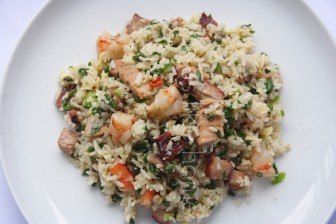Hi Everyone, last August when I was in Guyana and on the hunt for Chinese food, pastries, etc, you know, a taste of home, everyone kept telling me that I must try the Yangzhou fried rice. Each person that recommended it had their personal pick in terms of which place had the best tasting Yangzhou fried rice. A few friends and I taste-tested several and there was a clear winner, more on that later.
Yangzhou fried rice, also known as Yangzhou Chao Fan or Yeung Chow Fried Rice is a very popular Chinese-style fried rice, and though there are many types of fried rice served in restaurants, it is the Yangzhou fried rice that is still the standard by which all other Chinese fried rice dishes are judged. In restaurants outside of China, it is sometimes indicated on the menu as ‘Special Fried Rice.’

So what is it that makes this fried rice so special and why is it that it costs more than the other fried rice we buy so regularly in our favourite restaurants? Perhaps it’s the combo of ingredients? Yangzhou fried rice has certain essential ingredients – char siu (Chinese barbequed pork), shrimp, eggs, green onions (shallots), peas and, of course, rice.
Have you noticed that whenever you go to order the Yangzhou fried rice that you have to wait a little longer? That’s because the rice for Yangzhou fried rice needs to be white and not coloured. Let me explain. In a restaurant certain items are prepped a particular way so that when an order comes in they can fire it up quickly. What this means is that when we order a regular fried rice, the rice is already cooked and tossed with dark soy sauce waiting for the order to come in – for a mixed, chicken, shrimp, beef or pork fried rice. For Yangzhou fried rice, the rice needs to be white and not coloured in any way; hence the wait when you order a Yangzhou fried rice. At one of the restaurants we went to order, we were told flat out that it would take an hour because they now had to cook and cool the rice. We placed our order and collected it later.

The Char Siu (barbecued pork) is what gives the Yangzhou fried rice that special sweetish flavour. Some restaurants only use the yolks to give that right yellow colour while others use the whole eggs. When cooking the fried rice, the rice is cooked with the eggs so that the eggs can coat the rice and give it a tender, fluffy texture. The lightly beaten eggs are added to the wok, slightly cooked and then the rice is added while the egg is still very liquid, so that it can coat the rice thoroughly. Flavour aids such as five-spice powder or toasted sesame oil are not used. With Yangzhou fried rice, it is the ingredients that must shine through. Often the only thing that is added – apart from salt and pepper – is a little oyster sauce.
The shrimp and pork must be cut into bite size pieces so that there is even cooking. As with most wok-style cooking, it is imperative that everything be prepared in advance before you even think about lighting the stove.
Are you ready to make some homemade Yangzhou fried rice? If you don’t want to go to the lengths of making your own Char Siu (which involves an overnight marinate and an hour’s cooking), you can certainly substitute with ham (and add a little sugar to the fried rice to get the little sweetish flavour). Or, you can go to your favourite Chinese restaurant and order a large serving of roast pork to use in the fried rice.
Yangzhou Fried Rice
Serves 6
INGREDIENTS
5 – 6 tablespoons vegetable oil
2 cloves garlic, minced
1 tablespoon minced ginger
Minced hot pepper to taste (optional)
½ pound of chopped prawns
1 cup green peas, thawed or 1 cup chopped bora
½ pound of chopped roast pork
½ cup sliced green onions (white and green parts)
3 large eggs, lightly beaten
6 cups cooked rice
1 tablespoon oyster sauce
Salt and pepper to taste
DIRECTIONS
1. Season shrimp with salt and pepper and set aside.
2. Heat wok or karahi until very hot then add 2 tablespoons oil
3. Add ginger, garlic and hot pepper and toss for 30 seconds.
4. Add shrimp and toss with garlic and ginger until shrimp turns pink. Remove the shrimp and seasonings from pan and set aside. Wipe karahi/wok and add another 2 tablespoons oil.
5. Toss in peas or bora along with pork and cook for 2 minutes or until the bora or peas turns bright green. Add green onions, toss for 30 seconds and them remove everything from the pan. Wipe the pan clean and add another 2 tablespoons oil.
6. Add the beaten eggs and let it set just slightly; throw in the rice and toss it with the eggs, letting the eggs coat the rice. Cook for about 1 – 2 minutes but do not let the rice change colour.
7. Add back the shrimp mixture, the pork and peas/bora mixture along with 1 tablespoon of oyster sauce and toss to mix everything.
8. Taste for seasoning and add salt and pepper to taste. Toss for a couple of minutes and remove from heat and serve immediately.
As to which Yangzhou fried rice the tasters and I liked best – the one from Hilton Chinese Restaurant (Garnett Street).
Cynthia





